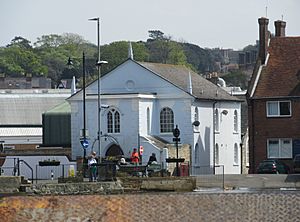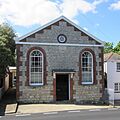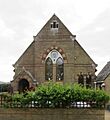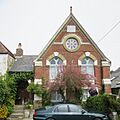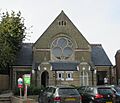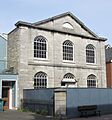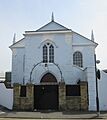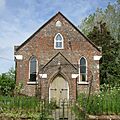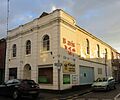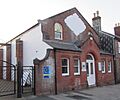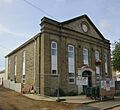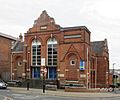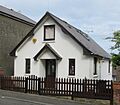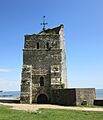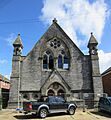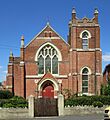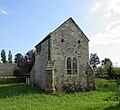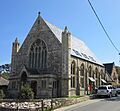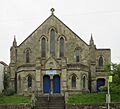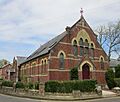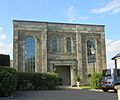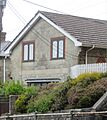List of former places of worship on the Isle of Wight facts for kids
The Isle of Wight is England's biggest island. It's shaped like a diamond and is about 146 square miles (378 square kilometers) big. Around 140,000 people live here, spread out in small towns and many villages.
As of 2020, there are more than 80 buildings on the Isle of Wight that used to be places of worship, like churches or chapels. These old buildings can be found all over the island. Many of them have been changed into new things. For example, some are now homes, holiday cottages, or even village halls. This happens when a church or chapel is no longer used for religious services.
Contents
What are Former Places of Worship?
A "place of worship" is a building where people go to pray or hold religious services. This includes churches, chapels, and meeting halls for different Christian groups. When these buildings are no longer used for their original purpose, they become "former" places of worship.
Why Buildings Change Their Use
Over time, communities change. Sometimes, there aren't enough people attending a church or chapel anymore. This can lead to the building closing down. When a religious building closes, it might be sold and given a new life. This helps to save these old buildings from falling apart. It also means they can still be useful to the community in a different way.
Protecting Old Buildings: Listed Status
Fifteen of these former churches and chapels on the Isle of Wight are considered very special. They have been given "listed status" by an organization called Historic England. This means they are important because of their history or their unique design.
A building gets "listed" when it's added to a special list of buildings that are important for their "architectural or historic interest." This helps to protect them. The government department in charge of this is the Department for Digital, Culture, Media and Sport. Historic England helps them decide which buildings to list.
Different Levels of Protection
There are three main levels, or "grades," of listed status:
- Grade I: These are buildings of "exceptional interest." They are super important, sometimes even known around the world.
- Grade II*: These are "particularly important buildings" that are more than just special.
- Grade II: These are buildings of "special interest" and are important nationally.
As of 2001, the Isle of Wight had 26 Grade I buildings, 55 Grade II* buildings, and 1,823 Grade II buildings.
There are also six other former churches that are "locally listed." This means the Isle of Wight Council thinks they are important to the island's local character. These buildings must meet at least two of these points:
- They have interesting history.
- They have good design or artistic value.
- They are still standing well.
- They add to the look of the town or village.
- They have archaeological interest (meaning they might have old things buried around them).
| Grade | What it means |
|---|---|
| Grade I | Buildings that are super important and sometimes known around the world. |
| Grade II* | Buildings that are very important and more than just special. |
| Grade II | Buildings that are important nationally and have special interest. |
| Locally listed (L) | Buildings that are important to the local area and its unique feel. |
Stories of Former Places of Worship
Many of these old buildings have interesting stories about their past and what they are used for now. Here are a few examples:
- Old St Boniface Church, Bonchurch: This church is very old, possibly from before 1086! Most of it was built in the Norman style. It closed in 1848 when a new church was built. Now, you can still see parts of 12th-century wall paintings inside. It's a Grade II* listed building.
- Wesleyan Methodist Chapel, Cowes: This large chapel opened in 1831 and could hold 820 people! It looked like a grand old Greek temple. When a new church was built in 1901, this one was sold. It was used by a boat-building company (which later became famous as Saunders-Roe), then as a dance hall, and even a printing company. Since 1966, it has been a house. It's a Grade II listed building.
- East Cowes Congregational Church: Built in 1829, this chapel was an interesting mix of old Gothic and grand Neoclassical styles. It closed in 1984 and was carefully changed into holiday apartments. This work even won a local award! It's a Grade II listed building.
- Old St Helen's Church, St Helens: This old church used to be right by the sea. By the 1500s, it was falling apart, so a new church was built inland in 1717. The tower of the old church was kept, but it was cut in half diagonally and painted white to act as a landmark for ships at sea! It's a Grade II listed building.
- Old St Lawrence's Church, St Lawrence: This simple 13th-century chapel was replaced by a much bigger church in 1878. It's a Grade II* listed building.
- Victoria Methodist Church, Newport: This beautiful chapel opened in 1804. It had a grand entrance with Doric columns. It closed in 1970 and was turned into a theatre. It's a Grade II* listed building.
- Old St Swithun's Church, Thorley: Most of this medieval church was knocked down in 1871 when a new church was built. What's left is a two-story porch and bell tower. It's a Grade II* listed building and now serves as a small chapel for funerals.
- Weston Manor Chapel, Totland: This chapel was part of a manor house built in 1869 for the Catholic Ward family. It was also open to the public. When a new church was built in 1923, this chapel was no longer used. The whole building is now a bed and breakfast! It's a Grade II* listed building.
- Yarmouth Methodist Church: This stone chapel was built in 1824 and rebuilt in 1881. It has a tall, pointed turret and a fancy window. It closed in the late 20th century, and the people who went there joined the local Anglican church, which became a shared church. This old chapel is now a house. It's a Grade II listed building.
These are just a few examples of how old religious buildings on the Isle of Wight have found new purposes, keeping their history alive while serving the community in different ways.
Images for kids


